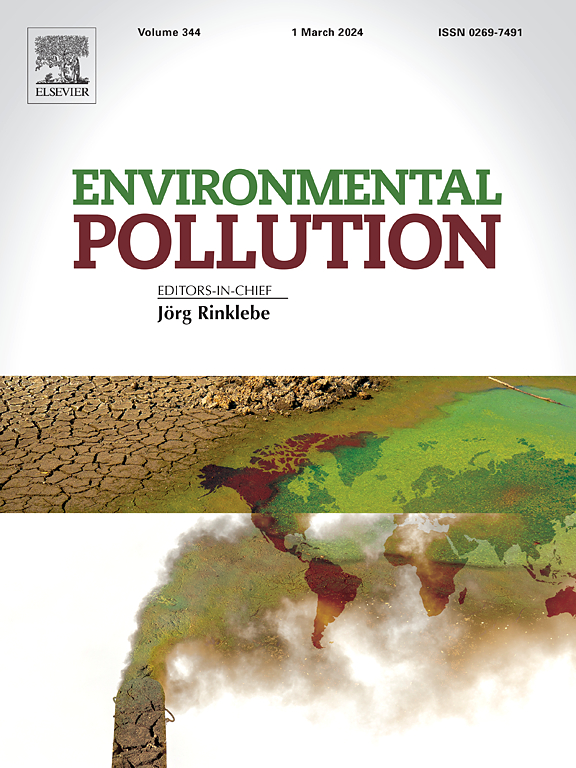Sex- and age-specific mercury contamination in Central Europe's last gull-billed tern population
IF 7.3
2区 环境科学与生态学
Q1 ENVIRONMENTAL SCIENCES
引用次数: 0
Abstract
Mercury contamination is a growing threat to ecosystems and wildlife due to its adverse effects on animal physiology and its potential to accumulate in long-lived top predators. Endangered species may be especially vulnerable, requiring contamination assessment at both the population- and individual-level. Between 2022 and 2024, we assessed total mercury (THg) contamination in the last population of gull-billed terns (Gelochelidon nilotica) in Central Europe, known to breed in a heavily mercury-polluted area, by collecting blood samples of adults and chicks. Among adults, THg concentrations were variable, but mostly below toxicity thresholds associated with major adverse health effects. They were higher in males than females, and higher when birds were sampled later in the season, but not related to clutch size. Using longitudinally collected data and a within-subject centering statistical approach, females, but not males, were found to accumulate THg as they aged. Chicks exhibited relatively low THg levels, which varied with age (following a bathtub-shape), but not sex. As such, our study suggests sex-specific mercury accumulation in gull-billed terns at levels that are currently associated with low to moderate health effects. We recommend continued monitoring of THg levels and assessing the levels of further contaminants, as well as how they may interact with mercury to affect the birds.


中欧最后一批鸥嘴燕鸥种群中特定性别和年龄的汞污染
汞污染对生态系统和野生动物的威胁日益严重,因为它会对动物生理产生不利影响,并可能在长寿的顶级捕食者体内积累。濒危物种可能特别脆弱,需要在种群和个体水平上进行污染评估。在2022年至2024年期间,我们通过收集成年和雏鸟的血液样本,评估了中欧最后一批鸥嘴燕鸥(Gelochelidon nilotica)的总汞(THg)污染,已知它们在汞严重污染的地区繁殖。在成人中,THg浓度是可变的,但大多数低于与主要不良健康影响相关的毒性阈值。它们在雄性中高于雌性,在季节晚些时候采样的鸟类中也更高,但与窝的大小无关。采用纵向收集的数据和以受试者为中心的统计方法,发现THg随年龄增加而增加的是女性,而不是男性。雏鸡表现出相对较低的THg水平,随年龄变化(遵循浴缸形状),但不随性别变化。因此,我们的研究表明,在鸥嘴鸥中,性别特异性的汞积累水平目前与低至中度健康影响有关。我们建议继续监测THg水平,并评估进一步污染物的水平,以及它们如何与汞相互作用。
本文章由计算机程序翻译,如有差异,请以英文原文为准。
求助全文
约1分钟内获得全文
求助全文
来源期刊

Environmental Pollution
环境科学-环境科学
CiteScore
16.00
自引率
6.70%
发文量
2082
审稿时长
2.9 months
期刊介绍:
Environmental Pollution is an international peer-reviewed journal that publishes high-quality research papers and review articles covering all aspects of environmental pollution and its impacts on ecosystems and human health.
Subject areas include, but are not limited to:
• Sources and occurrences of pollutants that are clearly defined and measured in environmental compartments, food and food-related items, and human bodies;
• Interlinks between contaminant exposure and biological, ecological, and human health effects, including those of climate change;
• Contaminants of emerging concerns (including but not limited to antibiotic resistant microorganisms or genes, microplastics/nanoplastics, electronic wastes, light, and noise) and/or their biological, ecological, or human health effects;
• Laboratory and field studies on the remediation/mitigation of environmental pollution via new techniques and with clear links to biological, ecological, or human health effects;
• Modeling of pollution processes, patterns, or trends that is of clear environmental and/or human health interest;
• New techniques that measure and examine environmental occurrences, transport, behavior, and effects of pollutants within the environment or the laboratory, provided that they can be clearly used to address problems within regional or global environmental compartments.
 求助内容:
求助内容: 应助结果提醒方式:
应助结果提醒方式:


